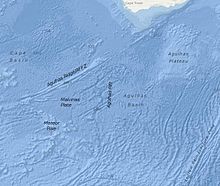Agulhas Basin

The Agulhas Basin is an
Geology
In a
The Agulhas Ridge extends from the northern tip of the Meteor Rise towards the Agulhas Bank south of South Africa. The ridge, however, ends abruptly in a small plateau at 40°S 15°E / 40°S 15°E where it intersects a northeastward-trending spreading centre (the Agulhas Rift) that was abandoned during the Early Paleocene (61 Ma).[1] The presence of a short-lived tectonic plate between these structures was first proposed by LaBrecque & Hayes 1979. They named it the Malvinas Plate and proposed that it was active from 90 Ma until the spreading ceased in the Agulhas Basin at 65 Ma. The plate is located at a proto-Bouvet Triple Junction.[2]
Marks & Stock 2001 found that Late Cretaceous (100-66 Ma) fracture zones generated on the Agulhas Rift do not align with those north of the Agulhas Fracture Zone and cannot therefore have been formed by the spreading of South America and Africa. Furthermore, magnetic anomalies on the Malvinas Plate do not align with their conjugates on the African Plate if the spreading rates and directions of South America and Africa are used as a guide. They also noted that the Agulhas Fracture Zone do not lay perpendicular to traces of the South America-Africa spreading north of it and cannot, therefore, have been generate by this spreading.[3]
The Agulhas Rift is the abandoned Malvinas-Africa ridge crest. 97 Ma the plate boundary in the Agulhas Basin was reorganised when the Mid-Atlantic Ridge made an eastward jump. This brought the boundary towards the Agulhas Plateau where excessive volcanism was building a large igneous province. The inception of the Malvinas Plate accompanied this shortening of the Agulas Fracture Zone. 61 Ma, the Malvinas Plate was finally incorporated into the African Plate when the Malvinas-Africa ridge was abandoned as the result of a westward ridge jump along the Agulhas-Falkland Fracture Zone.[4] This second ridge jump reduced one of the most spectacular fracture zones in Earth's history — 1,200 km (750 mi) in length — to 180 km (110 mi).[5]
Oceanography
The
References
Notes
- ^ a b c Raymond & LaBrecque 1988, Introduction, p. 27
- ^ Raymond & LaBrecque 1988, Agulhas Fracture Zone Ridge, pp. 28-29
- ^ Marks & Stock 2001, Abstract; Marks 2001
- ^ Pérez-Díaz & Eagles 2014, 4.5 The Short Life of a Small Plate in the South Atlantic (80 Ma to Present), p. 19; Figs. 13-14, pp. 16-17
- ^ Bird 2001, Agulhas-Falkland Fracture Zone, p. 152
- ^ Beal et al. 2011, p. 1
- ^ Dencausse, Arhan & Speich 2010, "Initial rings" and "sub-rings", pp. 6-7
- ^ Schut, Uenzelmann-Neben & Gersonde 2002, Oceanography, p. 187
Sources
- Beal, L. M.; De Ruijter, W. P. M.; Biastoch, A.; Zahn, R.; SCOR/WCRP/IAPSO Working Group 136 (2011). "On the role of the Agulhas system in ocean circulation and climate". Nature. 472 (7344): 429–436. S2CID 4424886.)
{{cite journal}}: CS1 maint: numeric names: authors list (link - Bird, D. (2001). "Shear margins: Continent-ocean transform and fracture zone boundaries" (PDF). The Leading Edge. 20 (2): 150–159. . Retrieved 4 January 2015.
- Dencausse, G.; Arhan, M.; Speich, S. (2010). "Routes of Agulhas Rings in the southeastern Cape Basin" (PDF). Deep-Sea Research Part I: Oceanographic Research Papers. 57 (11): 1406–1421. . Retrieved 10 July 2015.
- LaBrecque, J. L.; Hayes, D. E. (1979). "Seafloor spreading history of the Agulhas Basin". Earth and Planetary Science Letters. 45 (2): 411–428. .
- Marks (2001). "Malvinas plate controversy resolved using altimetry" (PDF). Earth System Monitor. 11 (4): 1–2, 4. Retrieved 10 July 2015.
- Marks, K. M.; Stock, J. M. (2001). "Evolution of the Malvinas Plate South of Africa". Marine Geophysical Researches. 22 (4): 289–302. S2CID 130601372.
- Pérez-Díaz, L.; Eagles, G. (2014). "Constraining South Atlantic growth with seafloor spreading data" (PDF). Tectonics. 33 (9): 1848–1873. . Retrieved 10 July 2015.
- Raymond, C. A.; LaBrecque, J. L. (1988). "Geophysical signatures of the Agulhas Fracture Zone Ridge and Meteor Rise, Indo-Atlantic basin" (PDF). Proceedings of the Ocean Drilling Program, Initial Reports. 114: 27–33. Retrieved 10 July 2015.
- Schut, E. W.; Uenzelmann-Neben, G.; Gersonde, R. (2002). "Seismic evidence for bottom current activity at the Agulhas Ridge" (PDF). Global and Planetary Change. 34 (3–4): 185–198. . Retrieved 10 July 2015.

